Trees Birds Mammals Fish Amphibians Reptiles
Wild Algarve
Bookshop
Phylum: Basidiomycota - Class: Agaricomycetes - Order: Agaricales - Family: Strophariaceae
Distribution - Taxonomic History - Etymology - Identification - Culinary Notes - Reference Sources
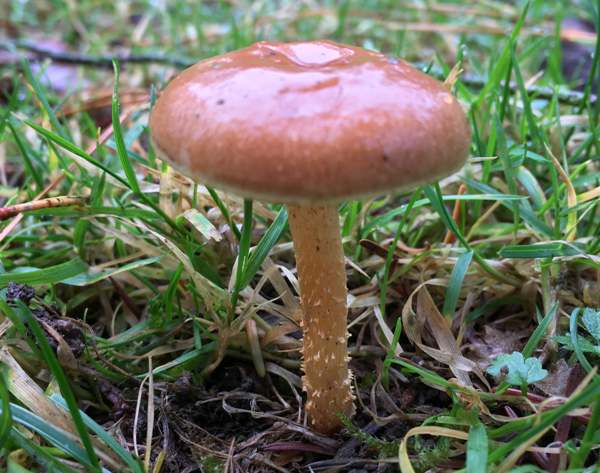
Pholiota lubrica, a rare find in Britain, is one of the most attractive of the so-called 'scalycap' mushrooms; it usually has a striking red-brown cap with a contrasting yellowish margin.
Distribution
A rare find in Britain and Ireland, Pholiota lubrica is also found in parts of northern and central mainland Europe. Very similar scalycap mushrooms have been recorded in parts of North America, but it is unclear whether they are co-specific with P. lubrica as found in northern Europe.
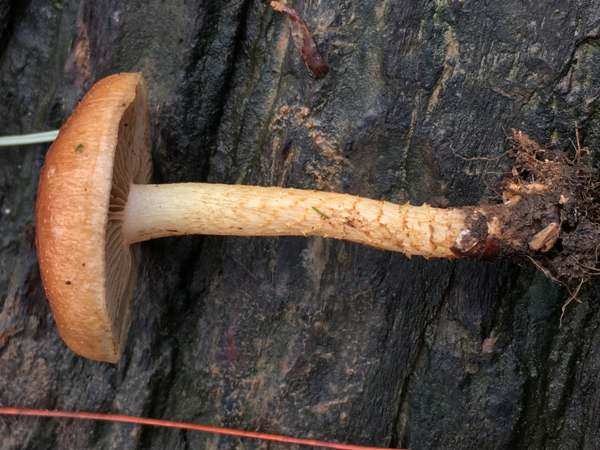
Taxonomic history
Described in 1801 by Christiaan Hendrik Persoon who named it Agaricus lubricus, this scalycap mushroom was moved to the genus Pholiota in 1951 by German-American mycologist Rolf Singer, thus establishing its currently-accepted scientific name as Pholiota lubrica.
Synonyms of Pholiota lubrica include Agaricus lubrica Pers., Flammula lubrica (Pers.) P. Kumm., Inocybe lubrica (Pers.) Roze, Dryophila lubrica (Pers) Quel., Flammulinopsis lubrica (Pers.) Fayod, and Gymnopilus lubricus (Pers.) S. Imai,
Etymology
The generic name Pholiota means scaly, and the specific epithet lubrica is a Latin adjective meaning 'slippery' or 'slimy' - a reference to the glutinous cap surface of this scalycap mushroom.
Identification guide
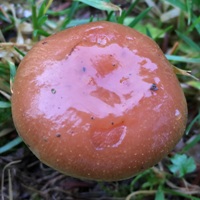 |
Cap
3 to 8.5cm in diameter, conico-convex or hemispherical at first then convex, eventually expanding to almost flat, sometimes with a low broad umbo; reddish brown with a paler yellowish margin and with
a glutinous surface. Small white scales from veil fragments cling to young caps, especially at the margin |
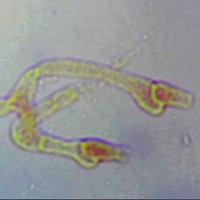 |
Pileipellis
An ixocutis of 2 - 5μm wide, cylindrical encrusted hyphae embedded in a hyaline gelatinous layer. Clamps (left) are present in the cap cuticle hyphal structure.
|
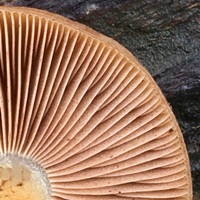 |
Gills
The moderately crowded adnate to subdecurrent gills are white or tinged pale yellow when young, turning orange-brown as the
spores develop but remaining paler at the gill edges. |
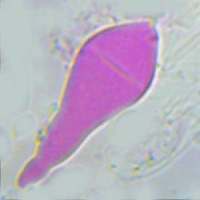 |
Cystidia
Pleurocystidia and cheilocystidia are abundant, clavate or lageniform to fusiform, 30-70 x 6-20μm.
|
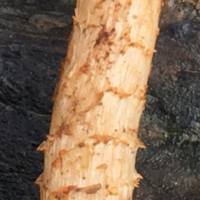 |
Stems
Cylindrical, 0.5 to 1.2cm in diameter and 4 to 9cm tall; dry; initially whitish turning yellowish and becoming rust-brown
towards the base; surface girdled with floccose brown scales (fragments
of the partial veil) below a fugacious median-to-superior ring zone. |
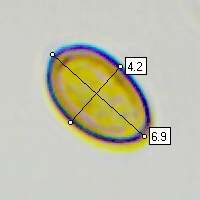 |
Spores
Ellipsoidal or slightly phaseoliform in side view; ovoid in front view, thin walled, smooth, 6-7 x 3.5-4.5μm with a small indistinct germ pore.
Spore print
Reddish-brown. |
Odour/taste |
Odour faint, pleasant but not distinctive; taste bitter. |
Habitat & Ecological role |
Singly or in tufts on buried rotten wood, rotting stumps, dead trunks and woody debris oin deciduous broadleaf and coniferous woodland; also on leaf litter or woodchip on roadside verges, in churchyards and in parkland. |
Season |
Late summer and autumn in Britain and Ireland. |
Similar species |
Pholiota squarrosa is usually paler with much larger cap scales.
Pholiota alnicola is paler; it has few scales and much larger spores; it grows on Alder trunks and stumps.
Pholiota aurivella has pale stems and much larger spores with very distinct germ pores. |
Culinary Notes
Despite their attractive appearance, these and other scalycaps (Pholiota species) are definitely not edible mushrooms, although in the past some members of this genus were considered to be so.
Reference Sources
Fascinated by Fungi, 2nd Edition, Pat O'Reilly 2016, reprinted by Coch-y-bonddu Books in 2022.
British Mycological Society (2010). English Names for Fungi
Funga Nordica, Henning Knudsen and Jan Vesterholt, 2008.
Dictionary of the Fungi; Paul M. Kirk, Paul F. Cannon, David W. Minter and J. A. Stalpers; CABI, 2008
Taxonomic history and synonym information on these pages is drawn from many sources but in particular from the British Mycological Society's GB Checklist of Fungi.
Acknowledgements
This page includes pictures kindly contributed by Simon Harding.
Top of page...
Fascinated by Fungi. Back by popular demand, Pat O'Reilly's best-selling 450-page hardback book is available now. The latest second edition was republished with a sparkling new cover design in September 2022 by Coch-y-Bonddu Books. Full details and copies are available from the publisher's online bookshop...